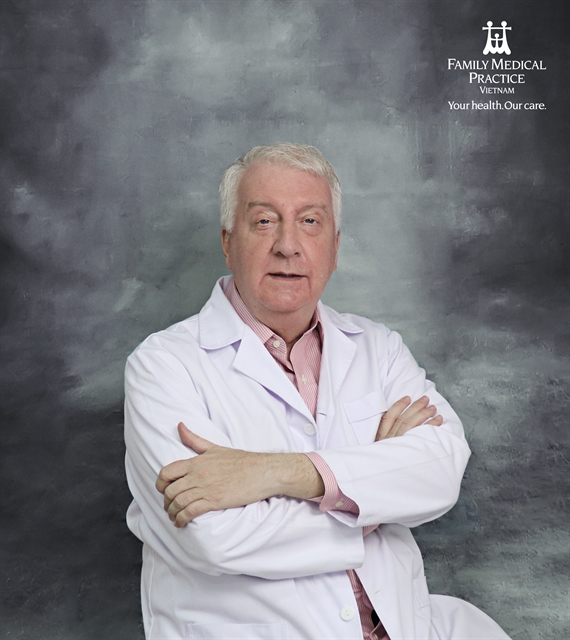 Life & Style
Life & Style

Osteoporosis, which means "porous bones", causes bones to become weak and brittle — so that even mild stresses like bending over, lifting a vacuum cleaner or coughing can cause a fracture.

|
| Dr Brian McNaull. – Photo courtesy of Family Medical Practice |
By Dr. Brian McNaull*
A brief summary of osteoporosis
Osteoporosis, which means "porous bones", causes bones to become weak and brittle — so that even mild stresses like bending over, lifting a vacuum cleaner or coughing can cause a fracture. In most cases, bones weaken when you have low levels of calcium, phosphorus and vitamin D. For Caucasian women over 50 years old, the prevalence of fracture is above 20 per cent but in Southeast Asia, the prevalence of fracture for women over 50 years old is higher than 25 per cent.
The most common result of osteoporosis is a fracture of the spine, hip or wrist. Thought of as a women's disease, osteoporosis also affects many men.
What are the warning signs of osteoporosis
In the early stages of bone loss (osteopenia), you usually have no pain.
* Back pain (severe) from a fractured or collapsed vertebra
* Loss of height over time, with stooped posture
* Fracture of the hip.
Bone strength depends on bone size and density; bone density depends in part on the amount of calcium, phosphorus and other minerals. With fewer vital minerals present than normal, bone is less strong and starts losing its internal supporting structure.
Bone is continuously remodelling. When you're young, new bone forms faster than old bone breaking down hence your bone mass increases. Peak bone mass is achieved by your mid-30s. After that, bone remodelling continues, but you lose slightly more than you gain. At menopause, when estrogen levels drop, bone loss in women increases dramatically.
The higher your peak bone mass, the more bone you have "in the bank" and the less likely you are to develop osteoporosis as you age.
What are the factors increasing the likelihood that you'll develop osteoporosis?
Gender or sex: Fractures from osteoporosis are about four times as common in women as they are in men (a sudden drop in estrogen at menopause accelerates bone loss). Men with low levels of the male hormone testosterone also are at increased risk.
Age: The older you get, the higher your risk.
Race: You're at greatest risk of osteoporosis if you're white or of Southeast Asian descent.
Family history: Having a parent or sibling with osteoporosis puts you at greater risk.
Tobacco and chronic alcohol use.
Lifetime exposure to estrogen: The greater a woman's lifetime exposure to estrogen, the lower her risk of osteoporosis. e.g. late menopause.
Corticosteroid medications: Long-term use of corticosteroid medications, such as prednisone or cortisone is damaging to bone. Used in chronic conditions, such as asthma, rheumatoid arthritis and psoriasis.
Thyroid hormone: Overactivity
Medicines: Some anti-depressants and anti-cancer (breast) treatment drugs e.g. methotrexate, can cause bone loss.
Low calcium intake: A lifelong lack of calcium plays a major role in the development of osteoporosis.
Medical conditions: Those decreasing calcium absorption such as Crohn's disease, celiac disease and vitamin D deficiency.
Sedentary lifestyle: Bone health begins in childhood. Children who are physically active and consume adequate amounts of calcium-containing foods have the greatest bone density.
Diagnosis
The best screening test is a dual-energy X-ray absorptiometry (DEXA). Quick and simple with accurate results, it measures the density of bones in your spine, hip and wrist.
Screening when?
Older than age 65, regardless of risk factors.
Postmenopausal.
Using medications, such as prednisone, that can cause osteoporosis.
Type 1 diabetes, liver disease, kidney disease, thyroid disease or a family history of osteoporosis.
Early menopause.
Have been physically inactive for months.
What keeps bones healthy?
* Regular exercise
* Adequate amounts of calcium in diet
* Adequate amounts of vitamin D, which is essential for absorbing calcium. – Family Medical Practice.
* Living in Hà Nội since 2006, Dr Brian is presently Medical Director of Family Medical Practice Hà Nội. Graduated in the UK, he has practiced medicine principally in Canada (1981-2005) until coming to Việt Nam. Post graduate medical training includes Cambridge University (Chronic Disease Epidemiology and Biostatistics), University College London (Tropical and Infectious disease) and University of Toronto Hospitals (Hospital for Sick Children – Hematology and Bone Marrow Transplant) and Mt Sinai Hospital (Hepatology – Clinical trials experimental liver/virology unit 1997-2006). He has conducted medical research, worked and lectured in various countries on infectious disease topics, epidemiology and liver disease (Canada, Việt Nam, Cambodia, Philippines). He is also weekly co-host of Radio the Voice of Việt Nam’s (VOV5) ‘Doctor at Home’.
Family Medical Practice was the first foreign-owned primary healthcare provider in Việt Nam, and has consistently remained at the forefront of international-standard medicine since 1995. It offers extensive healthcare and emergency medical services nationwide to Vietnamese, expatriate and corporate customers.
For more advice on any medical topics, visit Family Medical Practice (FMP) Hà Nội at: 298 I Kim Mã, Ba Đình. Tel: (024) 3843 0748. Email: hanoi@vietnammedicalpractice.com.
FMP’s downtown Hồ Chí Minh City location is: Diamond Plaza, 34 Lê Duẩn, District 1; 95 Thảo Điền St, Dist 2. Tel: (028) 38227848. Email: hcmc@vietnammedicalpractice.com
FMP Đà Nẵng is located at 96-98 Nguyễn Văn Linh St, Hải Châu Dist, Đà Nẵng. Tel: (0236) 3582 699. Email: danang@vietnammedicalpractice.com.




